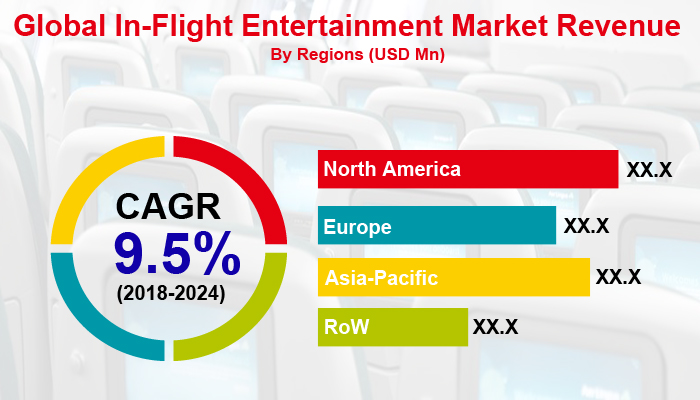In-Flight Entertainment Market: Global Industry Analysis, Trends, Market Size and Forecasts up to 2024
A recent report published by
Infinium Global Research on in-flight entertainment market provides in depth
analysis of segments and sub-segments in global as well as regional markets of
in-flight entertainment market. The study also highlights the impact of
drivers, restraints and macro indicators on the global and regional markets of
in-flight entertainment over the short term as well as long term. The report is
a comprehensive presentation of trends, forecast and dollar values of global
in-flight entertainment market. According to report the global in-flight
entertainment market is projected to grow at a CAGR of 9.5% over the forecast
period of 2018 - 2024.
Market Insights
With rise in significant demand
for the in-flight entertainment systems, the new entertainment systems
companies offering W-IFE software and hardware are growing at a rapid pace. The
growth in this market is attributed to the factors such as growing competition
among the aviation companies by providing enhanced customer experience, growing
number of air-travelers and technological advancements. Additionally, mobile
devices such as smartphones, tablets and laptops manufacturing companies have
started offering wireless in-flight connectivity and entertainment services to
customers, such factors are also likely to drive the In-flight entertainment
market. However, high cost associated with networking technologies, hardware
connectivity, and increased concerns about data privacy and security are
expected to restrain the growth of the market. Moreover, the combination of
wireless in-flight connectivity and in-flight entertainment have opened several
growth opportunities for the players in this market, and they are now offering
value added services such as live movies, live content and other services, this
in turn is projected to augment the opportunities in this market over the
upcoming years.
Segments Covered
The report on global in-flight entertainment
market covers segments such as type, system and product. The type segments
include air interface and core network. On the basis of system the global
in-flight entertainment market is categorized into centralized self-organizing
network, hybrid self-organizing network and distributed self-organizing
network. Furthermore, on the basis of product the in-flight entertainment
market is segmented as hardware, connectivity & communication and content.
Geographic Coverage
The report provides regional analysis covering geographies such as North America, Europe, Asia-Pacific, and Rest of the World. In this section the key trends and market size for each geography is provided over the period of 2016 – 2024.

The countries covered in the North
America region include the U.S., Canada, and Mexico; while Asia-Pacific
includes China, Japan, India, South Korea, Malaysia and among others. Moreover,
European region covers countries such as Germany, UK, France, Spain, and rest
of Europe. The U.S. drives the growth in the North America region as it is the
largest market in the region. The Asia-pacific region offers a substantial
potential for the market growth owing to rapid growth in markets such as India
and China. The APAC region is projected to experience a growth at a CAGR of
x.x% over the period of 2018 - 2024.
Companies Profiled:
The report provides profiles of
the companies in the global in-flight entertainment market such as, Lufthansa
Systems GmbH & Co. KG, Zodiac Aerospace, Gogo LLC, Thales Group, Global Eagle
Entertainment, Inc, Onair, Panasonic Avionics Corporation, Honeywell
International Inc, Digecor, Inc., and Rockwell Collins, Inc.
Report Highlights:
The report provides deep insights
on demand forecasts, market trends and micro and macro indicators. In addition,
this report provides insights on the factors that are driving and restraining
the global in-flight entertainment market. Moreover, IGR-Growth Matrix analysis
given in the report brings an insight on the investment areas that existing or
new market players can consider. The report provides insights into the market
using analytical tools such as Porter’s five forces analysis and DRO analysis
of in-flight entertainment market. Moreover, the study highlights current
market trends and provides forecast from 2018 to 2024. We also have highlighted
future trends in the in-flight entertainment market that will impact the demand
during the forecast period. Moreover, the competitive analysis given in each
regional market brings an insight on the market share of the leading players.
Additionally, the analysis highlights rise and fall in the market shares of the
key players in the market. This report will help manufacturers, suppliers and
distributors of the in-flight entertainment market to understand the present
and future trends in this market and formulate their strategies accordingly.
